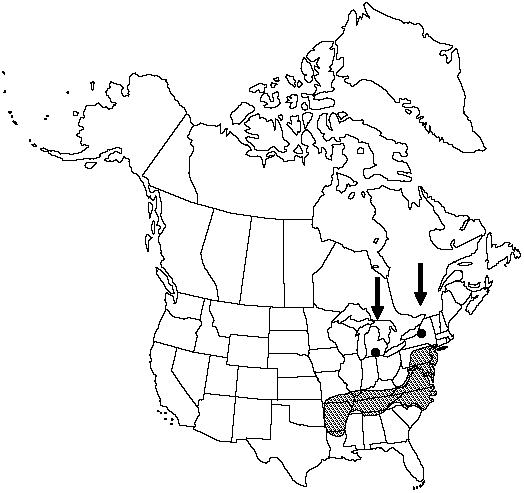Difference between revisions of "Dryopteris celsa"
W. Palmer, & Pollard, Proc. Biol. Soc. Wash. 13: 202. 1900.
FNA>Volume Importer |
imported>Volume Importer |
||
| Line 8: | Line 8: | ||
}} | }} | ||
|common_names=Log fern | |common_names=Log fern | ||
| + | |special_status={{Treatment/ID/Special_status | ||
| + | |code=E | ||
| + | |label=Endemic | ||
| + | }} | ||
|basionyms={{Treatment/ID/Basionym | |basionyms={{Treatment/ID/Basionym | ||
|name=Dryopteris goldiana subsp. celsa | |name=Dryopteris goldiana subsp. celsa | ||
| Line 29: | Line 33: | ||
|elevation=50–800 m | |elevation=50–800 m | ||
|distribution=Ala.;Ark.;Del.;Ga.;Ill.;Ky.;La.;Md.;Mich.;Mo.;N.J.;N.Y.;N.C.;Pa.;S.C.;Tenn.;Va.;W.Va. | |distribution=Ala.;Ark.;Del.;Ga.;Ill.;Ky.;La.;Md.;Mich.;Mo.;N.J.;N.Y.;N.C.;Pa.;S.C.;Tenn.;Va.;W.Va. | ||
| − | |discussion=<p><i>Dryopteris celsa</i> is a fertile allotetraploid derived from hybridization between | + | |discussion=<p><i>Dryopteris celsa</i> is a fertile allotetraploid derived from hybridization between D. goldieana and <i>D. ludoviciana</i>. <i>Dryopteris celsa</i> hybridizes with six species; hybrids can usually be identified by the dark-striped scales.</p> |
|tables= | |tables= | ||
|references= | |references= | ||
| Line 50: | Line 54: | ||
|publication title=W. Palmer, & Pollard, Proc. Biol. Soc. Wash. | |publication title=W. Palmer, & Pollard, Proc. Biol. Soc. Wash. | ||
|publication year=1900 | |publication year=1900 | ||
| − | |special status= | + | |special status=Endemic |
| − | |source xml=https:// | + | |source xml=https://bibilujan@bitbucket.org/aafc-mbb/fna-data-curation.git/src/bb6b7e3a7de7d3b7888a1ad48c7fd8f5c722d8d6/coarse_grained_fna_xml/V2/V2_221.xml |
|genus=Dryopteris | |genus=Dryopteris | ||
|species=Dryopteris celsa | |species=Dryopteris celsa | ||
Revision as of 21:11, 27 May 2020
Leaves monomorphic, dying back in winter, 65–120 × 15–30 cm. Petiole 1/3 length of leaf, scaly at least at base; scales scattered, dark brown or tan with dark central stripe. Blade green, ovate-lanceolate, gradually tapering to tip, pinnate-pinnatifid, herbaceous, not glandular. Pinnae ± in plane of blade, lanceolate-ovate; basal pinnae linear-oblong, much reduced, basal pinnules longer than adjacent pinnules, basal basiscopic pinnule and basal acroscopic pinnule equal; pinnule margins crenately toothed. Sori midway between midvein and margin of segments. Indusia lacking glands. 2n = 164.
Habitat: Seepage slopes, hammocks and logs in swamps, mostly on the Piedmont and Coastal Plain
Elevation: 50–800 m
Distribution

Ala., Ark., Del., Ga., Ill., Ky., La., Md., Mich., Mo., N.J., N.Y., N.C., Pa., S.C., Tenn., Va., W.Va.
Discussion
Dryopteris celsa is a fertile allotetraploid derived from hybridization between D. goldieana and D. ludoviciana. Dryopteris celsa hybridizes with six species; hybrids can usually be identified by the dark-striped scales.
Selected References
None.